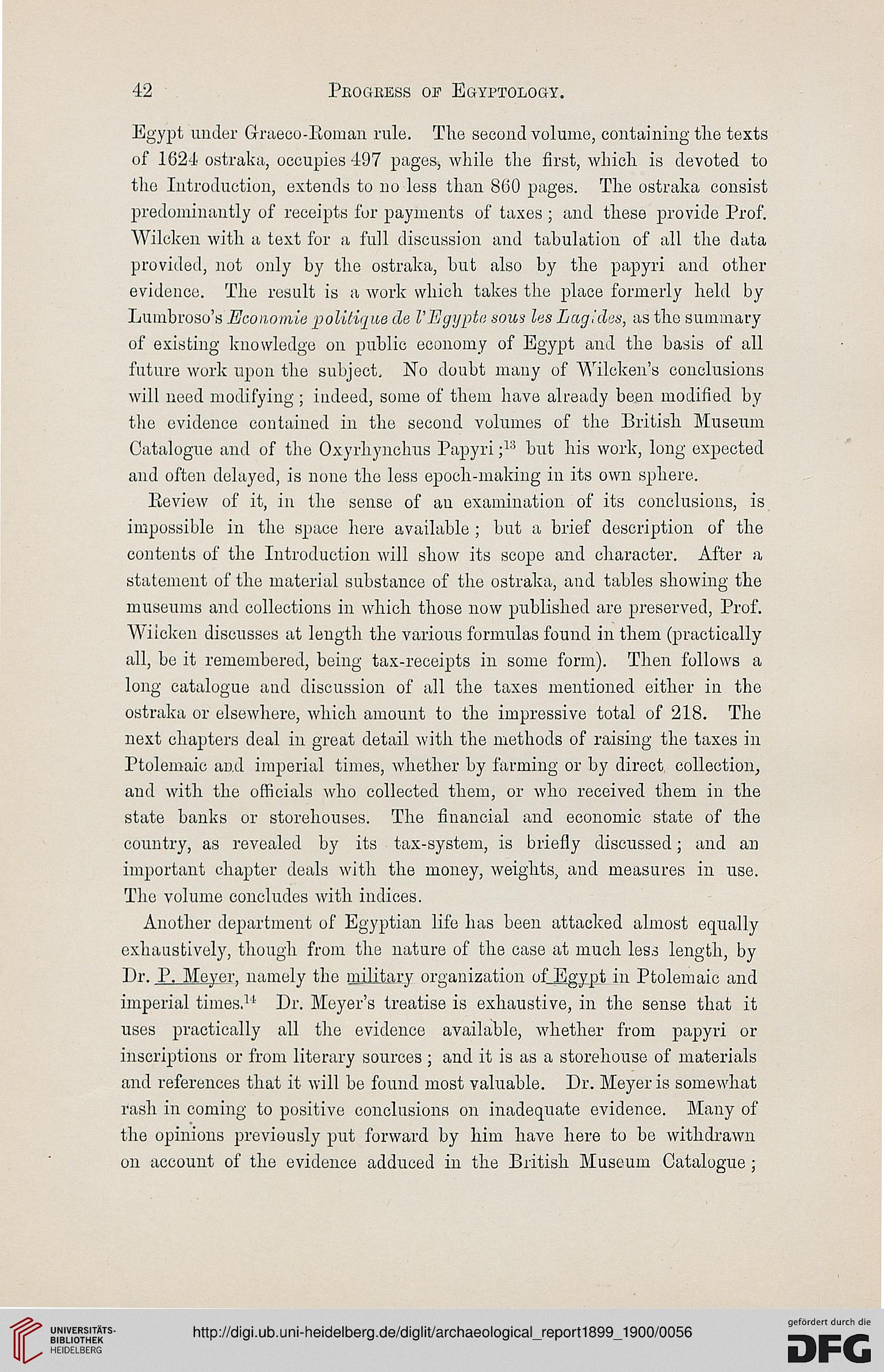42
Progress op Egyptology.
Egypt under Graeco-Boman rule. The second volume, containing the texts
of 1624 ostraka, occupies 497 pages, while the first, which is devoted to
the Introduction, extends to no less than 860 pages. The ostraka consist
predominantly of receipts for payments of taxes ; and these provide Prof.
Wilcken with a text for a full discussion and tabulation of all the data
provided, not only by the ostraka, hut also by the papyri and other
evidence. The result is a work which takes the place formerly held by
Luinbroso's Economie politique de I'Egypte sous lea Lag ides, as the summary
of existing knowledge on public economy of Egypt and the basis of all
future work upon the subject. No doubt many of "YYileken's conclusions
will need modifying ; indeed, some of them have already been modified by
the evidence contained in the second volumes of the British Museum
Catalogue and of the Oxyrhynchus Papyri ;18 but his work, long expected
and often delayed, is none the less epoch-making in its own sphere.
Eeview of it, in the sense of an examination of its conclusions, is
impossible in the space here available ; but a brief description of the
contents of the Introduction will show its scope and character. After a
statement of the material substance of the ostraka, and tables showing the
museums and collections in which those now published are preserved, Prof.
Wiicken discusses at leugth the various formulas found in them (practically
all, be it remembered, being tax-receipts in some form). Then follows a
long catalogue and discussion of all the taxes mentioned either in the
ostraka or elsewhere, which amount to the impressive total of 218. The
next chapters deal in great detail with the methods of raising the taxes in
Ptolemaic and imperial times, whether by farming or by direct collection,
and with the officials who collected them, or who received them in the
state banks or storehouses. The financial and economic state of the
country, as revealed by its tax-system, is briefly discussed; and an
important chapter deals with the money, weights, and measures in use.
The volume concludes with indices.
Another department of Egyptian life has been attacked almost equally
exhaustively, though from the nature of the case at much less length, by
Dr. P. Meyer, namely the military organization of Egypt in Ptolemaic and
imperial times.11 Dr. Meyer's treatise is exhaustive, in the sense that it
uses practically all the evidence available, whether from papyri or
inscriptions or from literary sources ; and it is as a storehouse of materials
and references that it will be found most valuable. Dr. Meyer is somewhat
rash in coming to positive conclusions on inadequate evidence. Many of
the opinions previously put forward by him have here to be withdrawn
on account of the evidence adduced in the British Museum Catalogue;
Progress op Egyptology.
Egypt under Graeco-Boman rule. The second volume, containing the texts
of 1624 ostraka, occupies 497 pages, while the first, which is devoted to
the Introduction, extends to no less than 860 pages. The ostraka consist
predominantly of receipts for payments of taxes ; and these provide Prof.
Wilcken with a text for a full discussion and tabulation of all the data
provided, not only by the ostraka, hut also by the papyri and other
evidence. The result is a work which takes the place formerly held by
Luinbroso's Economie politique de I'Egypte sous lea Lag ides, as the summary
of existing knowledge on public economy of Egypt and the basis of all
future work upon the subject. No doubt many of "YYileken's conclusions
will need modifying ; indeed, some of them have already been modified by
the evidence contained in the second volumes of the British Museum
Catalogue and of the Oxyrhynchus Papyri ;18 but his work, long expected
and often delayed, is none the less epoch-making in its own sphere.
Eeview of it, in the sense of an examination of its conclusions, is
impossible in the space here available ; but a brief description of the
contents of the Introduction will show its scope and character. After a
statement of the material substance of the ostraka, and tables showing the
museums and collections in which those now published are preserved, Prof.
Wiicken discusses at leugth the various formulas found in them (practically
all, be it remembered, being tax-receipts in some form). Then follows a
long catalogue and discussion of all the taxes mentioned either in the
ostraka or elsewhere, which amount to the impressive total of 218. The
next chapters deal in great detail with the methods of raising the taxes in
Ptolemaic and imperial times, whether by farming or by direct collection,
and with the officials who collected them, or who received them in the
state banks or storehouses. The financial and economic state of the
country, as revealed by its tax-system, is briefly discussed; and an
important chapter deals with the money, weights, and measures in use.
The volume concludes with indices.
Another department of Egyptian life has been attacked almost equally
exhaustively, though from the nature of the case at much less length, by
Dr. P. Meyer, namely the military organization of Egypt in Ptolemaic and
imperial times.11 Dr. Meyer's treatise is exhaustive, in the sense that it
uses practically all the evidence available, whether from papyri or
inscriptions or from literary sources ; and it is as a storehouse of materials
and references that it will be found most valuable. Dr. Meyer is somewhat
rash in coming to positive conclusions on inadequate evidence. Many of
the opinions previously put forward by him have here to be withdrawn
on account of the evidence adduced in the British Museum Catalogue;





